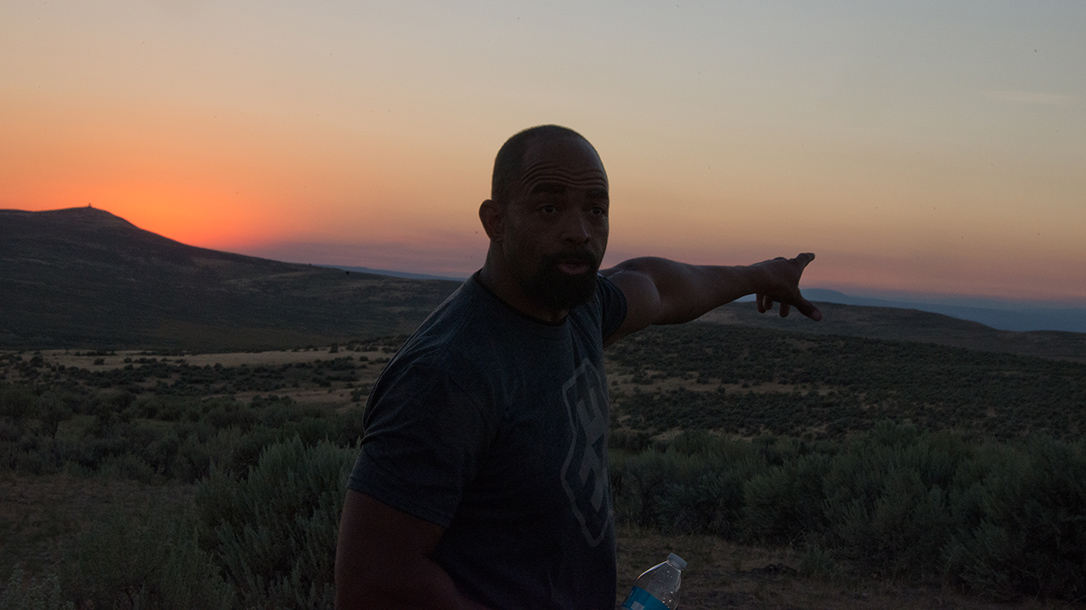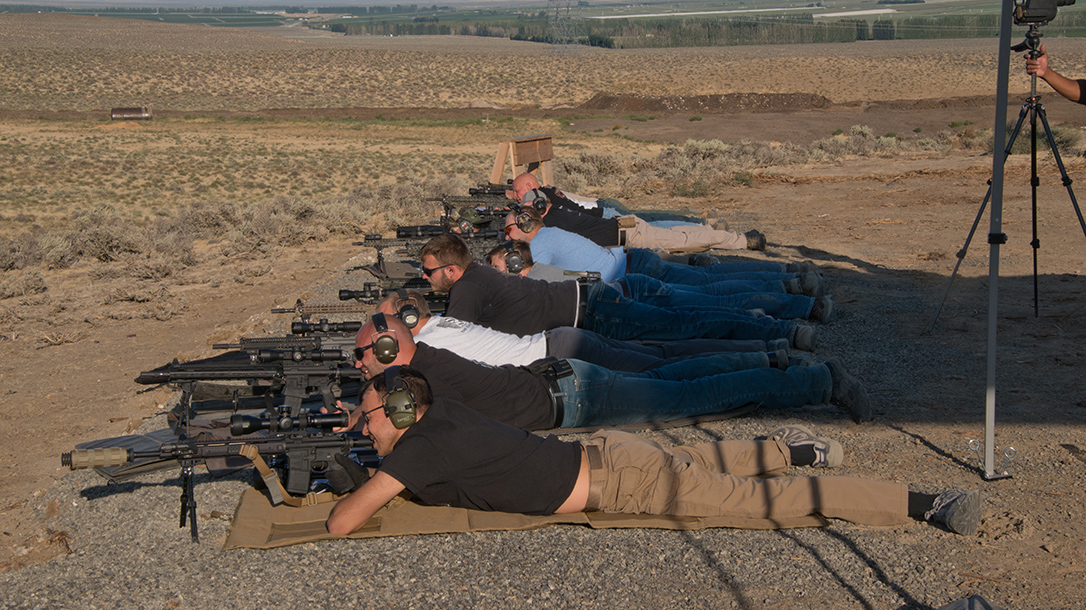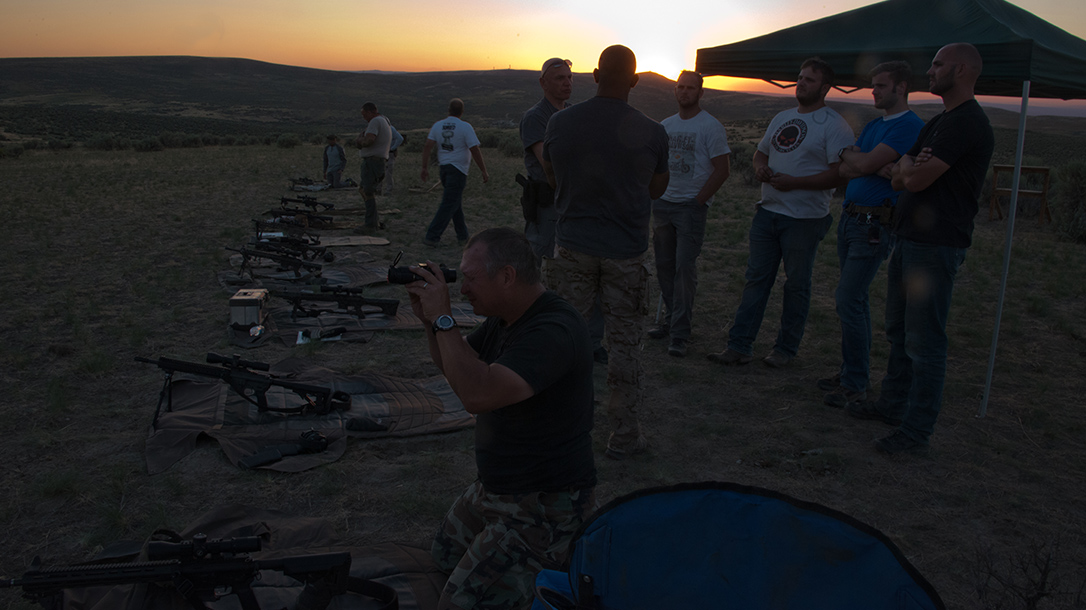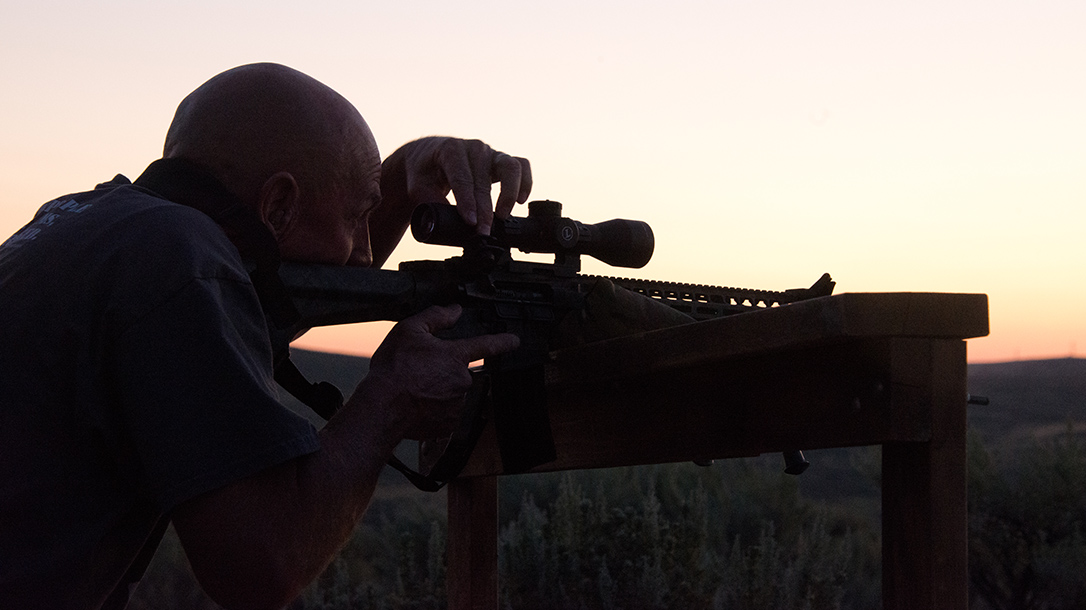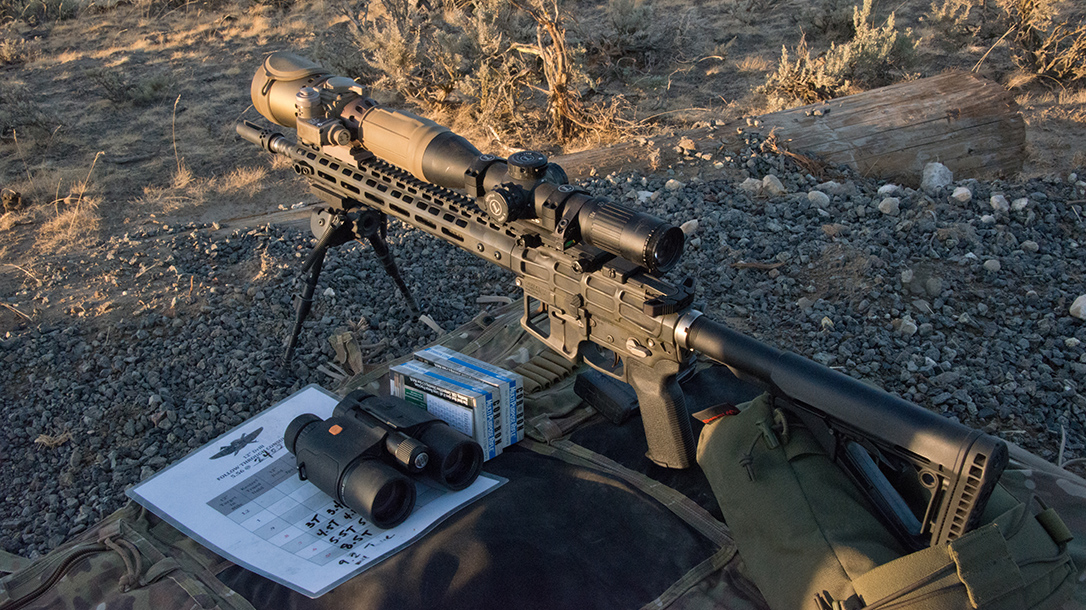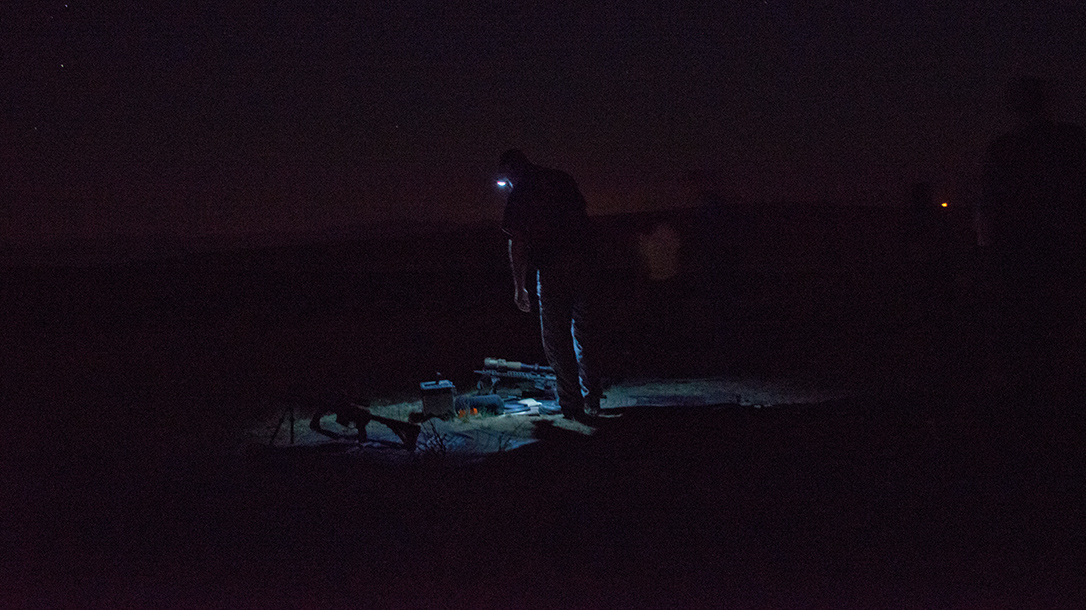The following article on Buck Doyle’s Follow Through Consulting is from the spring 2017 issue of Ballistic Magazine. To subscribe, please visit OutdoorGroupStore.com.
The tendency is to look at most rifle training through a close-quarters battle, or CQB, lens. But law enforcement officers and civilians with acres of property to protect should find low-light and long-distance training useful, too. Shooters in the non-tactical world often use carbines at longer ranges, oftentimes with night-vision devices. Think of the farmers and ranchers who have no choice but to actively and aggressively hunt hogs, coyotes and other predators at night and at distance. I recall a peanut plantation in Georgia a few years ago where hunters had to work in shifts during the night to protect the crop from ravaging hogs.
Advertisement — Continue Reading Below
Ranchers in the west, too, hunt coyotes and other livestock-taking predators regularly. Nighttime operations seem to be most effective on these types of critters. So if you’re ready to embark on some night hunting, it’s a good idea to train properly to truly understand the advantages and limitations of your gear before you begin your mission.
Follow Through Consulting’s Course Overview
Follow Through Consulting’s Night Fighter/Scoped Carbine course, run by owner and instructor Buck Doyle, is a version of the company’s standard Scoped Carbine class held at night. You shoot from afternoon on into the night every day—including on day one.
Just like the daytime class, the Night Fighter course makes extensive use of scopes with Horus T2 and T3 reticles. This way everything is done in the scope—there’s no knobs to turn and no complicated math conversions. You are engaging mostly 12-inch targets with some slightly larger steel targets at longer ranges. This scope setup is about as simple as it gets, and it’s seriously effective at night.
Advertisement — Continue Reading Below
For this course, Doyle teamed up with Tactical Night Vision Company (TNVC), which adds the latest in night-vision gear to the equation. TNVC is an industry leader in night vision, offering excellent service and a complete line of thermal and standard night-vision scopes.
TNVC’s Don Edwards brings along several handheld and clip-on devices for use in this particular class. Unlike most training, students are encouraged to try different TNVC models and switch them up as needed. This kind of variety and support is rarely present in training courses. Of course, if you have your own night-vision gear, feel free to bring it along, too.
Maughn Ranch
Follow Through Consulting holds these classes at a couple of venues and can go mobile if needed. The class I attended was held on the Maughn Ranch in Mattawa, Wash.
Advertisement — Continue Reading Below
Situated about 45 minutes from Richland, Wash., this is a working cattle ranch with gun ranges in excess of a mile wide with plenty of wind. The range has a deck for dialing in your rifle with other shooting areas only limited by your imagination.
Given the wide open spaces, Night Fighter/Scoped Carbine attendees can shoot in low-light and truly dark conditions. So this turned out to be a great venue for night-visition training.
Dialing In
For this course I used a 300 Blackout rifle built by EraThr3. Based on the company’s Grunt model, my rifle for this course sported a 16-inch Proof Research barrel and a carbine-length gas system. For targeting, the rifle was set up with Dueck Defense RTS offset sights and a Leupold 3-18x44mm Mark 6 scope using an illuminated Horus T3 reticle.
Advertisement — Continue Reading Below
As for ammo, I tried out a CorBon load using 125-grain Sierra Tipped MatchKing (TMK) bullets, which have become by go-to projectiles for 5.56mm NATO rifles. Loaded to just more than 2,500 fps, this 300 BLK load should be viable out to 400 meters, with its sweet spot right around 300 meters, and the bullet’s extra weight should offer impressive terminal ballistics.
Getting hits on a calm day is pretty easy, but it gets a lot trickier when you add wind gusting at 20 mph. This allowed me to work out holds on 12-inch steel using the T3 reticle.
The “12-inch rule” is a simple formula that allows for fast target acquisitions at extended ranges. Based on mil measurements, you can get on target pretty easily out to 600 meters. If the target is at 0.8 mils, subtract 0.8 from 1.0 and you’ll get a 2-mil hold. It’s easier to move the decimal and use 10 for most guns. Faster guns use 9, while slower guns use an 11 or even 12.
Advertisement — Continue Reading Below
TReMoR reticles make it easy with built-in scales. It’s in the center of the T2 and along the horizontal line in the T3. Wind is measured using dots. How much wind each dot represents changes with the ammunition. It can range from 3 to 5 mph per dot. You can do some math, or better yet, shoot into the wind, which is exactly what day one was all about.
As expected from 300 meters and in, it was pretty easy to get on the 12-inch steel target even in some stiff wind. Beyond that, you needed to be precise. Miss a wind call and you were off by quite a bit.
As I got better at reading the wind, getting on the target in two rounds with near misses was pretty easy out to 418 meters. Misread it beyond that and misses could be substantial. Still, the 300 BLK rounds delivered a noticeable punch at that range, whacking the steel.
Advertisement — Continue Reading Below
The rifle’s accuracy at 300 meters was excellent, consistently holding under 1 MOA. CorBon’s ammunition was very consistent and never caused a single issue. Long a fan of this chambering, using the 16-inch barrel and carbine- length gas system proved very effective. Overall, the EraThr3 rifle was excellent.
Owning the Night
For the night portion of the coures, I mounted one of TNVC’s latest clip-on scopes—one that uses a white background instead of a green one. For me it was much easier to see and it seems to be supplanting most current devices in the SMU communities. It’s just a lot brighter.
Advertisement — Continue Reading Below
For me, it was less about seeing the 200-meter steel and more about finding it. Many shooters are starting to use thermal imagers to find targets that emit heat, then night vision to identify and engage as needed. Searching with a clip-on device is less than optimal. Even using a handheld monocular was easier in terms of finding targets. You also notice a difference in locating targets as the moon rises and moves across the sky. In moonlight, the target can almost disappear.
On the second night, movement was added along with shooting from barricades at various levels. Most targets were in the 300- to 400-meter range. We had the chance to move from daylight into low and failing light, then in darkness running the same course.
Finding targets at night from prone is hard enough, but if you add in a racing heart rate and a less-than-pristine position, it gets even harder. The same goes for angles, as night vision offers no depth perception. Most of the angles we used for firing were not terribly severe, so hits on a standard silhouette were possible, but expect it to be a bit more difficult on a hog or coyote. This a much steeper learning curve than most think.
Advertisement — Continue Reading Below
Blackout Basics
Some shooters want to restrict the viability of the 300 Blackout to 200 yards and in, but that is just not practical. For example, this EraThr3 Grunt is easily a 300-meter rifle, delivering plenty of energy at that range using 125-grain TMK bullets or similar ammunition. It’s not a long-range cartridge per se, but it’s well within most every “typical” range outside specific military operations. Move back to urban distances (real, not perceived) and you are delivering a solid .30-caliber bullet with devastating ballistics and precision.
I recently tested the CorBon 125-grain SMK load alongside some of Black Hills’ .300 Whisper round using my bolt gun, and they both created tight groups at 100 yards. Both were loaded to the limit, making just more than 2,500 fps. My best group at 300 yards was under 3 inches, so these loads are accurate. Sierra’s 125-grain TMK projectile has proven to open up completely at velocities as low as 1,800 fps, making it a solid self-defense or hunting caliber at appropriate ranges.
Final Thoughts
Night vision is great stuff, but it’s not magic. There is a reason cutting-edge models integrate standard night vision and thermal capabilities. While this might not be within reach for most of us, a combination unit is probably in order. Don’t automatically assume a more reasonable version won’t suffice. Take the time to contact TNVC and have them walk you through it. It will save you some money and get you what you need. Better yet, get out to one of Buck Doyle’s classes.
As usual, Buck’s training course was excellent. As a former combat Marine, he has a ton of experience, and he teaches in a clear and professional manner. He keeps things moving with as little downtime as possible. Buck places you outside your comfort zone to help you improve. Having hunted critters at night that shoot back, he keeps things real. This course helps you get a feel for the strengths and limitations of night vision.
The range at Maughn Ranch was just about perfect for this class. It offered lots of space and was easy to get around. Joseph Maughn is an excellent host, and the venue is very well controlled. If you are traveling, think about staying in Richland. There is only one hotel that is close and its works, but it’s less than stellar. It was clean and close, but marginal overall. Richland offers restaurants and other amenities. Class starts late in the afternoon each day, so you’ll have plenty of time to make the 45-minute drive to the ranch.
I highly recommended this class for anyone who wants to improve their carbine skills and get a real feel for shooting in low, failing and no light. Come prepared with a basic skillset, a good rifle and the best ammunition you can get, and you will have the most fun and learn at the same time. Either way, you will leave a much better shooter than when you arrived, no matter how much light you have.
For More Information
- Follow Through Consulting — followthroughconsulting.com
- Leupold — leupold.com; 800-538-7653
- Proof Research — proofresearch.com; 406-756-9290
- Tactical Night Vision Company — tnvc.com; 909-796-7000
This article is from the summer 2017 issue of Ballistic Magazine. To subscribe, please visit OutdoorGroupStore.com.
